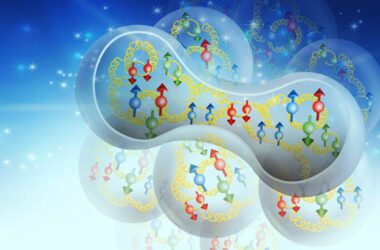
Le sol regorge de virus. Crédit : Stephanie King Pacific Northwest National Laboratory
Les scientifiques du PNNL découvrent de nouveaux virus du sol
Le sol est le héros méconnu de nos vies. Il nourrit les cultures pour donner de la nourriture aux humains, draine les précipitations dans les aquifères et sert d’habitat à une variété d’organismes. À l’échelle microscopique, le sol regorge de micro-organismes tels que des champignons et des bactéries qui coopèrent avec les plantes. Bien qu’il s’agisse d’un aspect aussi crucial de notre existence, on sait peu de choses sur ce qui se trouve sous la surface de la Terre.
Des scientifiques du Pacific Northwest National Laboratory (PNNL) ont utilisé la bioinformatique et le séquençage profond pour détecter les virus du sol et mieux comprendre leurs rôles dans la Terre dans une nouvelle recherche. La plupart de ces virus infectent les bactéries et sont donc supposés jouer un rôle clé dans le maintien des populations microbiennes.
“Les virus sont abondants dans la nature”, a déclaré Janet Jansson, scientifique en chef pour la biologie et membre du laboratoire du PNNL. “Comme ils sont très nombreux dans chaque échantillon de sol, l’identification des différents virus devient un défi.”
Jansson a travaillé avec Ruonan Wu, scientifique informaticien, et Kirsten Hofmockel, scientifique de la Terre et chef d’équipe de la science du microbiome, dans la division des sciences biologiques du PNNL, pour relever ce défi.
Avec des collaborateurs de l’Université d’État de Washington, de l’Université des sciences et de la santé de l’Oregon, de l’Université d’État de l’Iowa et de l’EMSL (Environmental Molecular Sciences Laboratory), une installation du PNNL utilisée par l’Office of Science du ministère de l’Énergie, les scientifiques du PNNL ont recueilli des échantillons de sol dans des prairies de l’État de Washington, de l’Iowa et du Kansas et ont entrepris une étude approfondie de la composition du sol. Ils ont exploité l’énorme DNA sequencing abilities of the Joint Genome Institute, computing power of the National Energy Research Scientific Computing Center, and multi-omics expertise from EMSL to unearth previously unknown soil viruses. Their results were published in mBio and Communications Biology.

From left to right: Janet Jansson, Ruonan Wu, and Kirsten Hofmockel pioneer research on soil viruses. Credit: Shannon Colson | Pacific Northwest National Laboratory
Different viruses for different climates
Because each site receives a varied amount of rainfall, the scientists picked Washington, Iowa, and Kansas for their soil samples. Eastern Washington is substantially drier than Iowa, whereas Kansas lies in the middle between the two in terms of soil moisture.
“We chose to take samples from places with different amounts of soil moisture to see if this made a difference in the types and amounts of viruses there,” said Wu. “Wetter soil contains more bacteria, and many soil viruses infect bacteria.”
The scientists noticed that certain viruses are much more abundant in dry soil than wet soil.
“In drier climates, there tend to be fewer, but more diverse, microbes in the soil,” said Wu. “The relative scarcity of bacterial hosts means that it’s in the virus’s best interest to keep the host alive.”
The researchers also discovered that in drier soil, viruses were more likely to contain special genes that they could potentially transfer to their bacterial hosts.
“These genes could potentially give their bacterial hosts ‘superpowers’” said Jansson. “These virus genes could be passed to their bacterial hosts to help them survive in dry soils.”
Though more research is necessary to better understand the role of these special viral genes, the possibility that they could be useful to bacteria living in the soil is exciting. These genes could be useful to bacteria by increasing their ability to recycle carbon and thus increase soil health.
This work was supported by the Department of Energy’s Office of Science Biological and Environmental Research program. This is a contribution of the scientific focus area “phenotypic response of the soil microbiome to environmental perturbations.” Portions of this research were performed by EMSL, the Joint Genome Institute, and the National Energy Research Scientific Computing Center at the Lawrence Berkeley National Laboratory.
References: “Moisture modulates soil reservoirs of active DNA and RNA viruses” by Ruonan Wu, Michelle R. Davison, Yuqian Gao, Carrie D. Nicora, Jason E. Mcdermott, Kristin E. Burnum-Johnson, Kirsten S. Hofmockel and Janet K. Jansson, 26 August 2021, Communications Biology.
DOI: 10.1038/s42003-021-02514-2
“DNA Viral Diversity, Abundance, and Functional Potential Vary across Grassland Soils with a Range of Historical Moisture Regimes” by Ruonan Wu, Michelle R. Davison, William C. Nelson, Emily B. Graham, Sarah J. Fansler, Yuliya Farris, Sheryl L. Bell, Iobani Godinez, Jason E. Mcdermott, Kirsten S. Hofmockel and Janet K. Jansson, 2 November 2021, mBio.
DOI: 10.1128/mBio.02595-21



